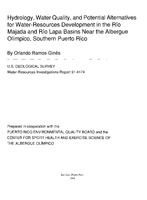A water-resources investigation was conducted during 1989 in the Rio Lapa mountain basins in southern Puerto Rico, to define the hydrology, water quality, and to describe alternatives for additional water- resources supply. The total water budget for both surface- and ground-water resources in the study area was estimated to be 7,530 acre-feet per year for 1989. The water budget for the ground-water system, from which water needs are supplied in the study area, was estimated to be 2,760 acre-feet per year for 1989. Concentration of dissolved solids and fecal bacteria increased during the dry season as both streamflow and ground-water levels decreased. Water samples collected at two stream sites exceeded the recommended U.S. Environmental Protection Agency fecal bacteria concentration for natural water of 2,000 colonies per 100 milliliters during June to November 1989. Water samples obtained from a well in the Rio Lapa Valley exceeded the secondary drinking-water standard for dissolved solids of 500 milligrams per liter during four dry months. In addition, fecal bacteria concentrations at this water-supply well exceeded the primary fecal- bacteria drinking-water standard of 1 colony per 100 milliliter during June to October 1989. Existing water resources can probably be developed to meet additional demands of 110 acre-feet per year pro- jected for 1995. Storage of the surface-water runoff during the wet season and its gradual release to the study area could offset ground-water declines during the dry season. Ground-water withdrawals can be increased by the construction and use of low- capacity wells to reduce the amount of water lowing out of the study area.


